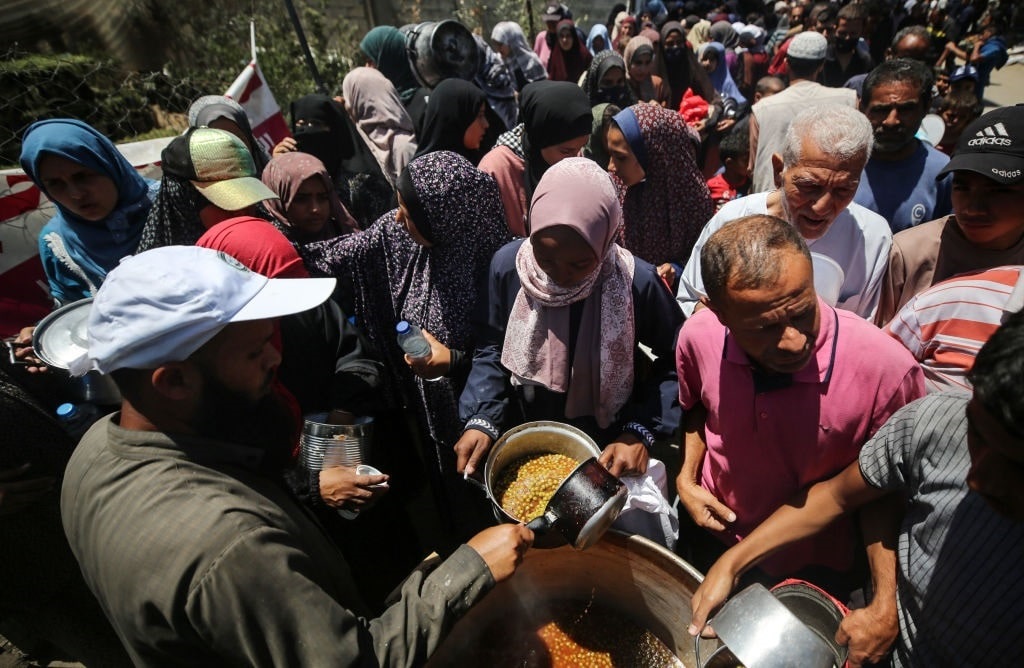On May 17, the first trucks trekked over the US-provided Joint Logistics Over the Shore (JLOTS) maritime dock and pier system to inaugurate the flow of humanitarian assistance to Palestinian refugees in Gaza. Now approximately 90 trucks a day cross, with an objective of 150. However, the intended recipients don’t seem to be getting the aid.
 Palestinians who fled their homes when the Israel Defense Force (IDF) gave warning of impending operations in their villages and neighborhoods are in dire need of food and other provisions. Land entrances into Gaza, mainly at the southern Gaza city of Rafah, are subjected to inspections to ensure Hamas terrorists are not bringing weapons and ammunition into the combat zone, and delays are common.
Palestinians who fled their homes when the Israel Defense Force (IDF) gave warning of impending operations in their villages and neighborhoods are in dire need of food and other provisions. Land entrances into Gaza, mainly at the southern Gaza city of Rafah, are subjected to inspections to ensure Hamas terrorists are not bringing weapons and ammunition into the combat zone, and delays are common.
This tortuous process starts in Cyprus, where pallets of materials are delivered by airlift or cargo ships. Once at transshipment centers in Cyprus, the humanitarian assistance is screened for movement through the maritime corridor to Gaza. “Once these supplies arrive in Gaza, humanitarian organizations, including trusted USAID partners, will determine how to ensure they reach those in greatest need in an independent, neutral and impartial manner consistent with humanitarian principles,” Sonali Korde, assistant to the administrator of the US Agency for International Development’s (USAID) Bureau of Humanitarian Assistance, told the Pentagon press corps.
Vice Admiral Brad Cooper, deputy commander of US Central Command (USCENTCOM), provided insights into the process at a press briefing. The JLOTS consists of a large floating platform made up of sections moved 6,000 miles across the ocean and assembled by US Army engineers and Navy personnel off the coast of Gaza. Large commercial and military ships travel from Cyprus carrying the palletized aid to the JLOTS, a stable floating docking platform anchored firmly, where the cargo is offloaded, placed on trucks, and driven onto smaller vessels with shallower drafts. Cooper explained:
“These smaller ships can carry between five and 15 trucks of aid and are called LSVs [Landing Support Vessels] or LCUs [Landing Craft Utility] in military jargon. The smaller ships then shuttle these trucks with pallets of aid from the floating platform to a temporary pier. Basically, this is a floating causeway that is several hundred meters long that is now fixed to the beach in Gaza. So, the aid goes from the floating platform to trucks that are on the small ships to the floating causeway, down the causeway, onto land, and then the commodities are dropped off.”
The IDF prepared the offload area in Gaza, where the temporary causeway is anchored. Cooper pointed out that once the aid is on the beach, it moves quickly, “within hours,” out of the marshaling area. Once out of the marshaling yards, the trucks are turned over to the United Nations and then to distribution warehouses. The admiral added that the flow level within the maritime corridor is subject to weather and sea conditions. Meteorological factors are favorable in the coming days and week or so, “and our goal is to move as much humanitarian assistance as possible during that period.”
The JLOTS and its associated pier are temporary fixes for getting much-needed humanitarian assistance to Palestinians threatened by malnutrition and medical distress. These refugees, located throughout Gaza, are attempting to stay out of the deadly combat brought about by Hamas and other Palestinian terrorist militias. The IDF is responsible for protecting the humanitarian aid operations.
Complex Process Getting Aid to Gaza
Though ground entry points into Gaza are the best means of providing trucks of humanitarian supplies, they are often closed because of IDF security concerns. Consequently, the JLOTS is a valuable complementary capability. Its effectiveness depends on complex coordination among the United States, United Kingdom, United Nations, numerous non-government humanitarian organizations, and the IDF. According to Navy Times, “The Pentagon said no backups were expected in the distribution process. The US plan is for the United Nations, through the World Food Program, to take charge of the aid once it leaves the pier.” That was the plan anyway.
The United Nations has no capacity to keep Hamas terrorists from stealing the aid so desperately needed by starving Palestinians. What did the US government expect? Though the first tranche of trucks arrived on Friday, May 17, but “on Saturday, only five truckloads made it to the warehouse after 11 others were cleaned out by Palestinians during the journey,” Reuters reported. There were no truck deliveries on May 19 and May 20. “According to Israeli estimates, Hamas has been stealing up to 60% of the aid entering the Gaza Strip, and a Channel 12 [Israeli Television] report last week revealed that the terrorist organization has made at least $500 million in profit off humanitarian aid since the start of the war on Oct. 7,” Jewish News Syndicate observed.
Though JLOTS is proving its worth in a high-visibility operation from the sea to the shore in Gaza, that’s where this important capability ends. According to USCENTCOM, at this writing, 569 metric tons have been delivered to Gaza through JLOTS. It appears Hamas terrorists are reaping the benefit.
The views expressed are those of the author and not of any other affiliate.




